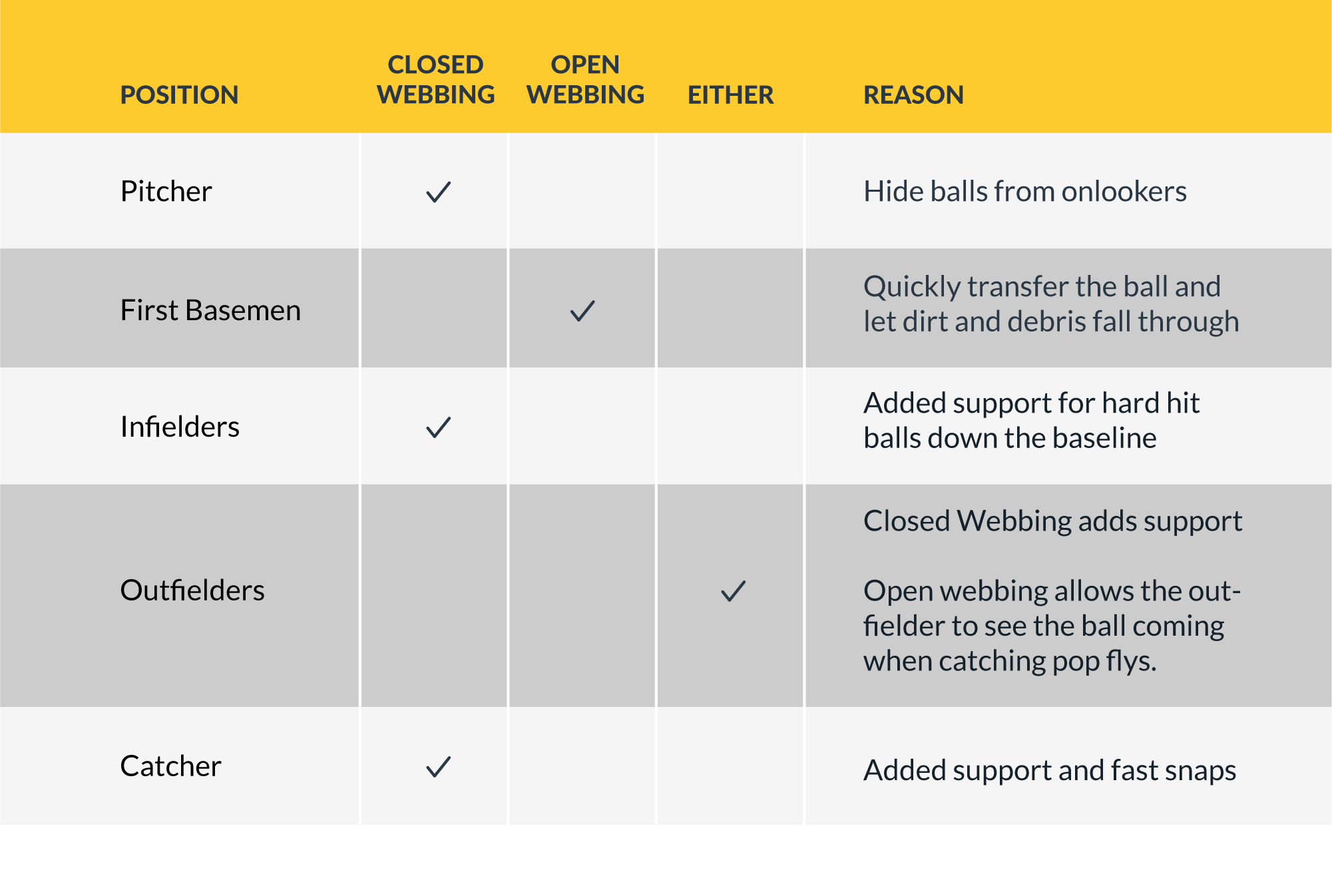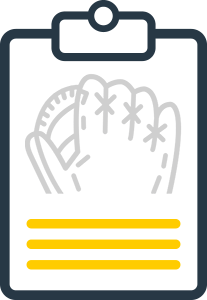Resource Guide | Gloves by Position
One of the most important things to consider when choosing a glove is what position you will be playing. The gloves for each specific position have certain attributes that help the player at his or her position.
Webbings of a Glove by Position
There are two basic types of webbing, open or closed. Pitchers often prefer a closed web to help them hide the ball from onlooking hitters. Outfielders and third basemen also tend to enjoy closed webs because of the extra support. Middle infielders tend to lean more towards an open web so they can transfer the ball out of their glove faster.

Pockets of a Glove by Position
The size of the pocket will depend on the position you play. Shallow pockets are built for middle infielders. This allows them to retrieve the ball quicker, and complete plays in a faster manner. Deeper pockets help outfielders secure fly balls with more consistency. Softball players will need a bigger pocket due to the larger size balls used. As a result, softball gloves are naturally made with larger pockets.
.jpg)
.jpg)
Backs of a Glove by Position
This portion of the glove is based on player preference and can be open or closed above the wrist on the backside of the glove. Middle infielders like an open back for the flexibility they afford. Outfielders often gravitate towards a closed back and a finger hole for the extra wrist support provided.
Shop by Position:
First Basemen Gloves
History of First Basemen Gloves
In 1870, the first glove worn by a baseball player was by catcher Doug Allison of the Cincinnati Red Stockings. According to reports at the time, he wore the glove because of an injured left hand. Conversely, A.G. Spalding believes the first glove he ever saw on a player was worn by Charles C. Waite, in Boston, in 1875. Waite was playing first base, and when asked by Spalding he said "He was a bit ashamed to wear it, but had it on to save his hand. He also admitted that he had chosen a color as inconspicuous as possible (flesh color as it was said) because he didn't care to attract attention." Spalding, who became the owner of A.G. Spalding and Bros. did not wear a glove until 1877. The glove Spalding wore was made from black leather and did draw attention to it. Since Spalding had made a name for himself, the attention was more out of pity than humor. By the mid-1890s, gloves were becoming not only more popular but also the new standard.
- First baseman wearing gloves became a standard in the late 1890s.
- First base mitts, as we know today, were invented in 1941.
- Early first base mitts had the five finger stalls with padding and then locked together with lacing between the thumb and index finger.
- Although it was primitive in make-up, the five finger stalls with padding style were effective and more widely adopted.
- First base mitts now offer open and closed backs, single post or double post webs, and modified or closed webs.
What to Look For in a First Baseman Glove:
- Main Characteristics: Single First base gloves are unique because the fingers aren’t separated. This allows first basemen to easily scoop up poorly thrown balls. They are also a bit longer than other gloves to help catch rolling balls.
- Webbing: Open Single-Post, Dual Post, or H-Webbing allow first basemen to grab balls from the ground without also digging up dirt and dust.
- Pocket Size: Large, deep pockets allow first base players to more securely grab and hold onto the balls that come their way.
- Other traits to look out for: First base gloves should be sturdy enough to take a high volume of pitches. Leather provides long-lasting strength to allow first basemen to catch ball after ball.
Today the first base mitts offer many different types of leather combinations from cowhide to kangaroo. Also, there are options with the color of your glove to the different features that your glove offers.
Catchers Mitts
History of Catcher's Mitts
The catcher's position is baseball's most physically demanding position. So, the need to improve catching equipment is important in order to add more protection and comfort. A catcher's mitt for people who play the position is a "must-have" because no other glove can provide the kind of support, protection, durability, and performance needed.
Baseball gloves, in general, became of widespread use by the 1870s. The first person to start producing and marketing ball gloves was Albert Spalding, who started his own mail-order sporting goods business. His mitts were a fingerless glove with padding in the palm. In the beginning, most of his business came from catchers who wanted more padding and protection for their mitts.
- In 1890, an ex-catcher by the name of Harry Decker patented his very own "Decker Safety Catcher's Mitt," which was a flat cushion with straps to hold it onto the hand specifically designed for catchers. These were basic designs, but they laid the groundwork for better and more advanced designs.
- Over the years catchers' mitts have added not only padding but have developed more of a basket pocket, similar to what we have today.
- Catcher's mitts now have an oval-shaped pocket and more padding and more flexibility. Today's gloves have been developed using the latest technology and are much stronger and durable.
- All of today's baseball catcher's mitts have a closed web.
What to Look For in a Catcher's Mitt:
- Main Characteristics: Like with a first baseman’s mitt, a catcher’s mitt does not have differentiated fingers. This is just right for catching and keeping balls that come your way. Catcher’s mitts are also well padded to help with catching high velocity throws.
- Webbing: A Closed Web or Modified Trap mitt works best for catchers to keep the ball in place.
- Pocket Size: Deep pockets help catch and hold the ball in place.
- Other traits to look out for: When selecting a baseball catcher's mitt, there are several things you need to keep in mind for you to select the right mitt. First, mitts come in different sizes, such as youth and adult sizes. But, you must also decide the glove circumference. Youth sizes have circumferences 31 inches or less, and adult mitts have circumferences 32 inches or greater.
When selecting a baseball catcher's mitt, there are several things you need to keep in mind for you to select the right mitt. First, mitts come in different sizes, such as youth and adult sizes. But, you must also decide the glove circumference. Youth sizes have circumferences 31 inches or less, and adult mitts have circumferences 32 inches or greater.
There is also the choice of an open back mitt that has an opening on the back of it right above the wrist, or there is a closed back which will have a finger hole for the index finger to be placed on the backside of the glove for more support. A few more factors to consider when choosing a catcher's mitt are 1) color and 2) brand preference.
Infield Gloves
History of Infield Gloves
In the very first years of baseball back in the 1860s and 1870s gloves were seen as unmanly. Then as the game gained popularity and players became better and hit the ball harder, gloves became more common and necessary for protection. The first infielder's gloves were a pair of gloves. They were leather gloves worn on each hand with the fingers cut off. By 1900, people started to wear only one glove on their non-throwing hand with more padding and a larger pocket. This was the beginning of the basic concept of the gloves we have today.
As time has gone by many improvements have taken place with gloves, especially infielder's mitts. With infielders having such little time to react having a good glove improves their play greatly. The most important improvement was in 1920 when a web was designed in between the thumb and the finger stalls. This gave the gloves a larger and deeper pocket
What to Look For in Infield Gloves:
- Pitcher Gloves: Pitchers want a glove that has a solid web; this is because the solid web will hide their fingers as they adjust their grip on the ball for the next pitch. As for the size of the glove for pitchers, it is up to personal preference.
- Middle Infielders: Smaller mitts allow middle infielders to transfer the ball out of the glove to their hand as quickly as possible. Open web gloves are also preferred by middle infielders such as an I-web or H-web style glove.
- Second Basemen: Second basemen wear the smallest gloves because they are lighter weight. Most second basemen use an 11 to an 11.5-inch mitt, while shortstops will usually use an 11.5 to an 11.75-inch mitt.
- Third Basemen: Third basemen, on the other hand, will ofter wear a bit larger glove around 12 to 12.5 inches long because they are the closest fielder to home plate. Balls hit at third base are the hardest hit and come in fast. Plus, a longer glove allows them to pick up balls hit down the foul line easier, because of the long reach of the glove.
- Other traits to look out for: Some other factors that can play a role in deciding which glove to choose is a brand preference or the color of the glove.
Outfield Gloves
History of Outfield Gloves
When gloves first became popular among those who played organized baseball, gloves were not specific to a position. Gloves were made from old mittens or custom made from horsehide with extra padding added to both designs. More and more padded designs became available as hitters began to hit the ball harder. In 1920 when Bill Doak of the St. Louis Cardinals approached Rawlings with his idea of lacing a web between the index finger and thumb to create a more natural pocket. This idea revolutionized the way gloves were made. This pocket design is what is still used today on all fielder gloves. It is like having an extra finger, All-Star Ozzie Smith who used this design once said: "six fingers are better than five."
What to Look For in Outfield Gloves:
- Main Characteristics: Outfielders often need large gloves with deep pockets to assure that they can catch and hold those far field, high-speed balls.
- Webbing: Outfielders prefer a closed web style.
- Size: Outfield gloves tend to be larger in design than infielder models in terms of the length of the finger stalls. These larger gloves allow outfielders to be able to cover more ground. Also, outfielders are looking to make a catch while infielders, who like smaller gloves, need to retrieve and release the ball as quickly as possible. Because of this, deep pockets are ideal for outfielders. Today many different models and sizes are available for outfielders. The most common sizes are from twelve inches and above depending on personal preference.
- Other traits to look out for: When selecting an outfielder's model, you will first need to select the size that best fits your personal needs. The next thing you need to think about is web style that you will like, whether that's an open web or a closed web. The third step will be to choose if you have a preference for an open back or a closed back. Your next decision will be to see if you have a brand preference. Finally, you will make the purchase that best fits your specific needs. Gloves have changed over time and will continue to change for the better of the game.
* Want help finding the perfect baseball glove or softball glove? Our knowledgeable Glove Experts are available by email: experts@justballgloves.com, Live Chat, or toll-free phone number: 1-866-321-4568! *



